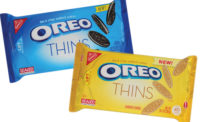According to data from IRI, Chicago, sales of frozen pizza were up about 1.15 percent in the 52 weeks ending August 7, 2016, representing about $4.5 billion. Unit sales, though, were down about 2.14 percent. Why?
“There is somewhat of a ‘premiumization’ going on,” says Mike Pytlinski, senior brand director, Palermo Villa, Milwaukee, WI. “The premium ($5.50 to $7.00 average retail price) and super premium (greater than $7.00) segments have grown substantially, while all other price segments have declined.” He chalks this up to an improving economy, but more so, a trend in the industry toward premium quality—and the pricing that goes along with it. “It reflects a larger macro consumer trend across many categories, where consumers are increasingly willing to pay a premium for products that deliver,” he says. “In addition to the trend toward more indulgent pizzas, we are seeing a trend toward healthier eating.”
Palermo Villa was one of the top sellers in the frozen pizza category, according to IRI, with 44.7 percent growth in dollar sales. Boulder Brands, a natural food company, was among the top sellers in the frozen pizza crust and dough segment, accounting for over $5 million of the segment’s $20 million in sales. Gluten-free options from Udi’s also surged to reach $5.4 million in sales.
Similar trends are taking over the refrigerated section, with IRI reporting that sales of pizza crust and dough were up about 10 percent, reaching $93 million.
Flavorful and artisan
If you ask Julie Adams, senior manager of consumer and marketplace trends at Schwan’s Consumer Brands, Inc., Bloomington, MN, there are two overarching trends defining today’s pizza category: “higher-quality ingredients, as well as innovation in the form of new formats, and bold, unique flavors. We expect that premium ingredients and cheeses, as well as unique toppings and sauces, will continue to be in the forefront for pizza trends as consumers are increasingly demanding more adventurous and interesting flavor combinations. Consumers are also looking for more-authentic preparation styles correlated with perceptions of quality and premiumization.”
At Schwan’s, says its culinary director, Michael Gunn, this translates to: flavors achieved through roasting, charring, caramelizing and pickling; topping pizza with classic sandwich ingredients; adding in ingredients from other cuisines to build interest; and going beyond traditional tomato sauces to bring different flavors to the table.
Red Baron Pizza, a Schwan’s brand, did a flavor exploration test in late 2014 and a crowd-sourcing campaign in March 2015 in order to help guide the brand’s flavor offerings. The result was two new varieties—Thin & Crispy Bacon Lovers and BBQ Style Chicken—launched at the beginning of 2016. According to Tracy Quigley, senior brand marketing manager, “Barbecue-style chicken is the No. 1 restaurant pizza flavor trend, and barbecue is the fastest-growing sauce in the pizza category. Bacon is the second-fastest-growing restaurant pizza topping trend.”
Crusts on top
When it comes to crusts, thin is in. “This seems to fit with a general trend toward lighter eating—consumers still want to enjoy pizza, but many want fewer carbs,” says Pytlinski. Palermo Villa recently put a creative spin on this trend with its Urban Pie launch, featuring a fusion of contemporary flavors atop a pastry-like crust, which was designed to bring quality-focused millennials back to the frozen aisle. Priced at about $7 to $9 per pie, it’s designed to “tempt consumers to envision trendy restaurants in some of the most popular neighborhoods,” he adds. The line includes varieties like The North End, with shiitake and crimini mushrooms, truffle Alfredo, rosemary, capers and caramelized onions; Lakeview, with sun-dried tomato, chicken sausage, fire-roasted yellow pepper, spinach and sun-dried tomato sauce; Little Italy, with fresh mozzarella, cherry tomato, basil and pesto sauce; and Mission District, with uncured pepperoni, chicken sausage, tomatoes, basil, green peppers, onions, crimini mushrooms and roasted red bell pepper sauce.
Crusts also have an important role to play in rising health demands and, to this end, Schwan’s Freschetta brand launched new artisan crust pizzas in May, which feature a crust made from 51 percent multigrain blend (white whole wheat, brown rice and oat flour). “We have combined the wholesomeness that today’s consumers are looking for, with a mix of traditional and more-unique ingredients that offer a whole new flavor level,” says Sishir Sekaran, Freschetta brand manager.
A bigger slice of the pie
In order to help brands meet consumer trends, equipment manufacturers are stepping up to offer next-generation technology when it comes to equipment for dough and topping application.
Rheon USA, Irvine, CA, manufactures the V4 Stress Free Flexible Width Divider, which allows brands to “make a sheet of dough at varying widths, which reduces the trim of unused dough, especially when making product diameter changes,” says John Giacoio, national sales director. This technology allows manufacturers to present a quality dough product with less rework. The result, he says, is improved bite, texture and cell structure.
Grote Company, Columbus, OH, offers the new TruTop MC Series Topping Applicator, which is ideal for border-free application of various ingredients, from shredded cheese to meat and vegetables. “Grote’s TrueTop MC Topping Applicator helps today’s pizza processors by providing them the ability to create pizzas with more-uniform distribution of ingredients across the crusts,” says Andy Schneider, sales manager, Americas. The applicator is fully adjustable, and changing pattern sizes takes just minutes.
Going forward, Ryan believes that the biggest challenge for the pizza category also represents its biggest opportunity. “Today’s millennial generation—and, increasingly, the baby boomer generation—is concerned with foods made with transparency in mind. Because pizza is not traditionally a better-for-you option, it has a tendency to be disregarded for seemingly healthier options in surrounding aisles,” he says. “Flavor and quality remain paramount for the category.”






